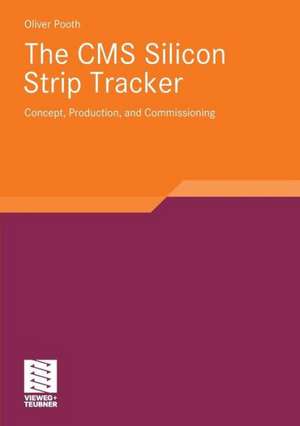The CMS Silicon Strip Tracker: Concept, Production and Commissioning
Autor Oliver Poothen Limba Engleză Paperback – 11 feb 2010
Preț: 378.54 lei
Nou
Puncte Express: 568
Preț estimativ în valută:
72.43€ • 75.83$ • 59.93£
72.43€ • 75.83$ • 59.93£
Carte tipărită la comandă
Livrare economică 08-22 aprilie
Preluare comenzi: 021 569.72.76
Specificații
ISBN-13: 9783834810038
ISBN-10: 3834810037
Pagini: 152
Ilustrații: 152 p. 109 illus., 6 illus. in color.
Dimensiuni: 148 x 210 x 15 mm
Greutate: 0.19 kg
Ediția:2010
Editura: Vieweg+Teubner Verlag
Colecția Vieweg+Teubner Verlag
Locul publicării:Wiesbaden, Germany
ISBN-10: 3834810037
Pagini: 152
Ilustrații: 152 p. 109 illus., 6 illus. in color.
Dimensiuni: 148 x 210 x 15 mm
Greutate: 0.19 kg
Ediția:2010
Editura: Vieweg+Teubner Verlag
Colecția Vieweg+Teubner Verlag
Locul publicării:Wiesbaden, Germany
Public țintă
ResearchCuprins
Semiconductor Detectors.- The CMS Silicon Strip Tracker.- Detector Production and Commissioning.- Conclusion.
Notă biografică
Dr. Oliver Pooth completed his postdoctoral lecture qualification at the RWTH Aachen University. He is a member of the CMS collaboration and now works as a private lecturer at the 3rd Physics Institute B at the RWTH Aachen University.
Textul de pe ultima copertă
With the start of the Large Hadron Collider LHC at CERN near Geneva, Switzerland, and the huge detectors along this particle accelerator, the largest high energy physics experiments ever are underway. One of the experiments is the CMS detector (Compact Muon Solenoid). With this experiment over 3,000 scientists and engineers worldwide will search for answers to fundamental questions in high energy physics.
Oliver Pooth describes the silicon strip tracker of the CMS detector. With a sensitive silicon area of 200 m² it is a central part of the experiment and able to precisely measure charged particles originating from high energy proton collisions at the LHC. In total, more than 15,000 individual silicon strip detector modules were built and tested before they were integrated on larger substructures of the silicon strip tracker. The author discusses methods of quality control that are new to the field of particle detector physics. These methods were established to guarantee a uniform behaviour of all detector modules which were built and tested in various places worldwide. After integration into the CMS experiment and commissioning, the silicon strip tracker is now ready to operate for at least ten years of LHC running.
Oliver Pooth describes the silicon strip tracker of the CMS detector. With a sensitive silicon area of 200 m² it is a central part of the experiment and able to precisely measure charged particles originating from high energy proton collisions at the LHC. In total, more than 15,000 individual silicon strip detector modules were built and tested before they were integrated on larger substructures of the silicon strip tracker. The author discusses methods of quality control that are new to the field of particle detector physics. These methods were established to guarantee a uniform behaviour of all detector modules which were built and tested in various places worldwide. After integration into the CMS experiment and commissioning, the silicon strip tracker is now ready to operate for at least ten years of LHC running.
Caracteristici
Concept, Production, and







